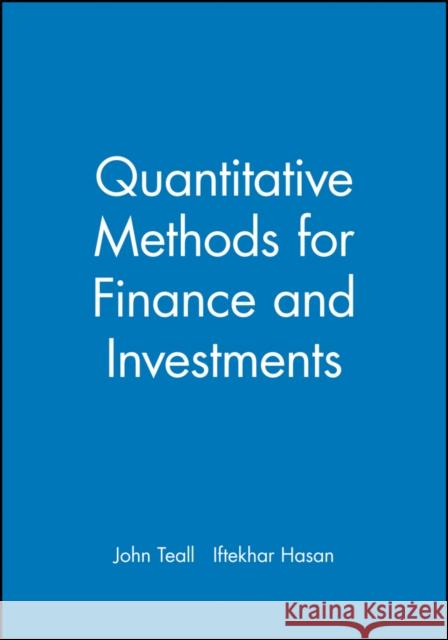Quantitative Methods for Finan » książka



Quantitative Methods for Finan
ISBN-13: 9780631223399 / Angielski / Miękka / 2002 / 304 str.
Quantitative Methods for Finan
ISBN-13: 9780631223399 / Angielski / Miękka / 2002 / 304 str.
(netto: 156,48 VAT: 5%)
Najniższa cena z 30 dni: 162,62
ok. 30 dni roboczych.
Darmowa dostawa!
Quantitative Methods for Finance and Investments ensures that readers come away from reading it with a reasonable degree of comfort and proficiency in applying elementary mathematics to several types of financial analysis. All of the methodology in this book is geared toward the development, implementation, and analysis of financial models to solve financial problems.
"This excellent text patiently guides the reader through a wide array of mathematics, ranging from elementary matrix algebra to differential and integral calculus. The quantitative methods are illustrated with a rich and captivating assortment of applications to the analysis of portfolios, derivatives, exchange, fixed income instruments, and equities. Undergraduate and MBA–level students who have read this book will feel comfortable with the mathematics in their finance courses and their professors can focus on teaching finance as it should be taught."
Kose John, Stern School of Business, New York University <1––end––>
"This volume provides a comprehensive review of mathematics which will prove invaluable for students of finance. It is a reference book for the nonmathematician and a clear and concise text that will help fill the gaps in students′ knowledge. Although the topic is quantitative methods, the organization, emphasis, applications, and numerous examples are all geared to the student of finance. Having Teall and Hasan on your bookshelf provides an essential safety net for students, teachers, and practitioners." Paul Wachtel, Stern School of Business, New York University
Preface.
Acknowledgments.
1. Introduction and Overview:.
The Importance of Mathematics in Finance.
Mathematical and Computer Modeling in Finance.
Money, Securities, and Markets.
Time Value, Risk, Arbitrage, and Pricing.
The Organization of this Book.
2. Review of Elementary Mathematics: Functions and Operations:.
Introduction.
Variables, Equations, and Inequalities.
Exponents.
The Order of Arithmetic Operations and the Rules of Algebra.
The Number e.
Logarithms.
Subscripts.
Summations.
Double Summations.
Products.
Factorial Products.
Permutations and Combinations.
Exercises.
Appendix: An Introduction to the ExcelT Spreadsheet.
3. A Review of Elementary Mathematics: Algebra and Solving Equations:.
Algebraic Manipulations.
The Quadratic Formula.
Solving Systems of Equations that Contain Multiple Variables.
Geometric Expansions.
Functions and Graphs.
Exercises.
Appendix: Solving Systems of Equations on a Spreadsheet.
4. The Time Value of Money:.
Introduction and Future Value.
Simple Interest.
Compound Interest.
Fractional Period Compounding of Interest.
Continuous Compounding of Interest.
Annuity Future Values.
Discounting and Present Value.
Present Value of a Series of Cash Flows.
Annuity Present Values.
Amortization.
Perpetuity Models.
Single–stage Growth Models.
Multiple–stage Growth Models.
Exercises.
Appendix: Time Value Spreadsheet Applications.
5. Return, Risk, and Co–movement:.
Return on Investment.
Geometric Mean Return on Investment.
Internal Rate of Return.
Bond Yields.
An Introduction to Risk.
Expected Return.
Variance and Standard Deviation.
Historical Variance and Standard Deviation.
Covariance.
The Coefficient of Correlation and the Coefficient of Determination.
Exercises.
Appendix: Return and Risk Spreadsheet Applications.
6. Elementary Portfolio Mathematics:.
An Introduction to Portfolio Analysis.
Portfolio Return.
Portfolio Variance.
Diversification and Efficiency.
The Market Portfolio and Beta.
Deriving the Portfolio Variance Expression.
Exercises.
7. Elements of Matrix Mathematics:.
An Introduction to Matrices.
Matrix Arithmetic.
Inverting Matrices.
Solving Systems of Equations.
Spanning the State Space.
Exercises.
Appendix: Matrix mathematics on a Spreadsheet.
8. Differential Calculus:.
Functions and Limits.
Slopes, Derivatives, Maxima, and Minima.
Derivatives of Polynomials.
Partial and Total Derivatives.
The Chain Rule, Product Rule, and Quotient Rule.
Logarithmic and Exponential Functions.
Taylor Series Expansions.
The Method of LaGrange Multipliers.
Exercises.
Appendix: Derivatives of Polynomials.
Appendix: A Table of Rules for Finding Derivatives.
Appendix: Portfolio Risk Minimization on a Spreadsheet.
9. Integral Calculus:.
Antidifferentiation and the Indefinite Integral.
Riemann Sums.
Definite Integrals and Areas.
Differential Equations.
Exercises.
Appendix: Rules for Finding Integrals.
Appendix: Riemann sums on a spreadsheet.
10. Elements of Options Mathematics:.
An Introduction to Stock Options.
Binomial Option Pricing: One Time Period.
Binomial Option Pricing: Multiple Time Periods.
The Black Scholes Option Pricing Model.
Puts and Valuation.
Black Scholes Model Sensitivities.
Estimating Implied Volatilities.
Exercises.
References.
Appendix A: Solutions to Exercises.
Appendix B: The z–Table.
Appendix C: Notation.
Appendix D: Glossary.
Index.
John L. Teall is Professor of Finance at Pace University. He has published numerous articles in scholarly journals and has served on university faculties around the world. Dr Teall is a former member of the American Stock Exchange and has done consulting work for many of the world′s leading financial institutions.
Iftekhar Hasan is Professor of Finance at the New Jersey Institute of Technology. He has published numerous articles in academic journals and has been associated with several universities and regulatory organizations in Europe. He is the co–editor of Research in Banking and Finance.
Quantitative Methods for Finance and Investments ensures that readers will gain a reasonable degree of comfort and proficiency in applying elementary mathematics to financial analysis in a variety of areas. All of the methodology in this book is geared toward the development, implementation, and analysis of financial models to solve problems encountered by both finance students and practitioners. The book: analyzes theoretical and practitioner–oriented models long with the mathematics required to construct them presents the most essential mathematical techniques and their applications to financial analysis provides dozens of practical applications, examples, and end–of–chapter exercises with detailed solutions demonstrates key spreadsheet applications of the mathematical models in chapter appendices emphasizes practical applications of modeling technique.
John L. Teall is Professor of Finance at Pace U... więcej >
1997-2026 DolnySlask.com Agencja Internetowa
KrainaKsiazek.PL - Księgarnia Internetowa









